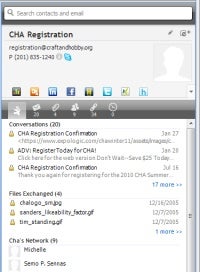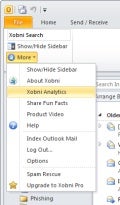Microsoft Outlook is vital small business software for many business people. With tools to handle not only email but also calendar, contacts and daily tasks, it’s a program small businesses rely on every day. Because of its importance in the business world, anything that makes Outlook easier to use or that gives you better access to your information can boost your productivity.
The oddly-named Xobni is a popular add-in for Outlook and deservedly so. Xobni makes up for some of Outlook’s weaknesses and delivers all the information stored in your Inbox to you in a way that’s both meaningful and unlike anything Outlook offers. I’ll show you how to find and get started with Xobni.
 The Xobni sidebar shows you a wealth of information about the people with whom you communicate. (Click for larger image). |
Get Xobni for Free
You can download a free version of Xobni from the company’s website. I suggest you start with the free version to see how the program works, and if you’ll use it. If you like it and you find the additional features in the paid version attractive, you can easily upgrade.
Once you have downloaded and installed Xobni, restart Microsoft Outlook. The program installs as a tab on the ribbon, and you access most of its functionality from a sidebar. If the sidebar isn’t visible, click the Xobni tab and click the Show/Hide Sidebar button.
Get More Out of Outlook
When you first load Xobni, it indexes the data in your Outlook files so it can find the information you need very quickly. Open your inbox and click on an email to select it — you don’t need to open it. In the Xobni sidebar you will see a wealth of detail relating to the person who sent the message.
This is one Xobni’s strengths — instead of showing details from the selected message only — Xobni aggregates into the sidebar the entire history of your communications with that person. It is mostly information from your Outlook folders, but it’s not readily available any other way.
Quickly Find Recipients and Senders
You can also find this information by typing a person’s name in the search box. Xobni will give you a list of matches for that name, and you can click the person whose details you want to view from the list that appears. The program ranks people in order of the importance that they have to you, and Xobni calculates this “importance” by looking at the volume of email messages exchanged between you and other people.
Regardless of how you get to the contact, you’ll find that person’s details at the top of the sidebar. This might include a photo, an email address, the company’s address and phone number. This data comes not only from Outlook email messages, but also from online sources such as LinkedIn and Facebook. Click the Edit icon to open a dialog that lets you add more information or change anything that is incorrect.
 The Xobni tab on the Ribbon gives you access to additional tools and configuration options. (Click for larger image). |
Extract Information from Emails
Below this personal “business card” information is a bar with icons including Summary, Conversations, Files Exchanged, Network and so on. The Summary information includes links to all email conversations that you’ve had with the person, files that you’ve exchanged and other people in their network. This latter information includes anyone who has been a party to an email message sent between you and the person whose details you are viewing – for example, being included in the CC line of an email. This information could be very hard to find otherwise.
Click on the Conversations icon to view a full list of the conversations between you and the other person. When you click on the Files Exchanged tab, you see links to every file the two of you have exchanged regardless of which email message it was included in. By simply searching for a person you get immediate access to all files you’ve ever exchanged, and you can drag-and-drop an attachment from this panel into a new message window.
You can also view emails in the Xobni sidebar. So, for example, when you find a person in Xobni, you can click on any linked email and it will appear in the sidebar. You can click to open the email message in a regular window, and then you can click to reply or forward it from the Xobni sidebar — without needing to locate the actual email in your Outlook inbox.
Xobni Options and Analytics
On the Xobni tab on the ribbon, click the More dropdown menu to access additional features. Select Xobni Analytics to view charts and other filtered information about the emails you send and receive.
The Options dialog gives you the capability to set various Xobni options including when the mail index is updated, what sort of data is brought into Xobni such as from Skype, LinkedIn and Facebook and other configurable options.
While Outlook does a good job of storing your emails it does a poor job of delivering the information in them to you quickly and in a usable way. Xobni fills this gap by mining emails and social networking sites to gather information and present it in a highly meaningful way to you. It’s a tool that is guaranteed to make any Outlook user smile.
Helen Bradley is a respected international journalist writing regularly for small business and computer publications in the USA, Canada, South Africa, UK and Australia. You can learn more about her at her Web site, HelenBradley.com
Small Business Computing is on Facebook. Join us on Facebook and interact with the site’s editors, post messages, share your small business challenges and successes, discuss technology and suggest topics you’d like covered on Small Business Computing.
| Do you have a comment or question about this article or other small business topics in general? Speak out in the SmallBusinessComputing.com Forums. Join the discussion today! |


